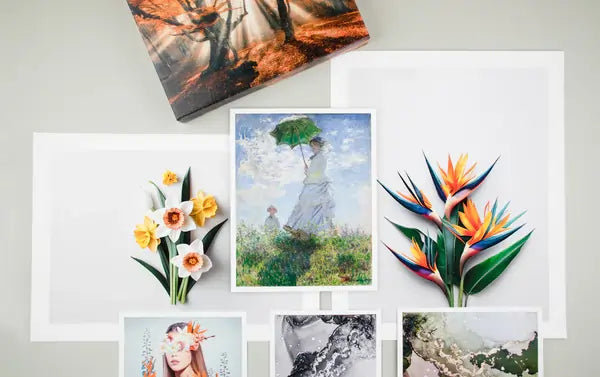One of the most important choices when printing your artwork is selecting the right paper surface. The texture of your paper directly affects how your image looks, feels, and interacts with light. Whether you prefer smooth or textured paper, understanding their unique qualities will help you choose the best fit for your artwork and audience.
What Is Smooth Paper?
Smooth fine art papers have a flat, even surface that allows ink to sit cleanly on top. This produces crisp details, sharp lines, and accurate color reproduction. Smooth papers are often used for photography, illustration, or digital artwork where precision is key.
Benefits of smooth papers:
- Excellent for artwork with fine lines or intricate detail
- Delivers consistent tone and clean gradients
- Best for modern or minimal styles
Popular smooth options at The Stackhouse Printery:
- Hot Press Bright (Epson): Smooth matte surface, bright white tone, and excellent for illustrations or prints with sharp edges.
- Photo Rag (Hahnemühle): Velvety matte paper that offers rich contrast and depth, ideal for photography or soft portrait work.
- Photo Matte Fibre: A smooth natural matte option for artists who prefer a subtle, non-reflective finish.
What Is Textured Paper?
Textured fine art papers mimic the feel of traditional art surfaces like watercolor or handmade cotton papers. The tactile grain adds character and dimension, helping printed artwork resemble original paintings or drawings. Texture also influences how light scatters across the surface, giving prints a softer, more organic appearance.
Benefits of textured papers:
- Adds depth and natural feel to reproductions of paintings or drawings
- Enhances the look of traditional media such as watercolor or pastel
- Reduces glare and reflection under direct light
Popular textured options at The Stackhouse Printery:
- Cold Press Bright (Epson): A lightly textured matte surface ideal for watercolor or mixed-media artwork.
- William Turner (Hahnemühle): A heavily textured paper that gives artwork a true handcrafted look.
- FineArt Baryta (Hahnemühle): Glossy with a subtle texture, perfect for photography that needs depth and a professional sheen.
Smooth vs. Textured: A Side-by-Side Comparison
| Feature | Smooth Paper | Textured Paper |
|---|---|---|
| Surface Feel | Flat and even | Natural grain or tooth |
| Best For | Illustrations, digital art, photography | Watercolor, mixed media, traditional painting reproductions |
| Color Appearance | Vibrant, high contrast | Softer tones with natural diffusion |
| Lighting Reflection | Clean matte or semi-gloss finish | Minimal glare with subtle texture variation |
| Archival Quality | 100+ years (with pigment inks) | 100+ years (with pigment inks) |
How to Choose Between Smooth and Textured Paper
The decision often depends on the medium of your artwork and the feeling you want your audience to experience. Ask yourself:
- Do you want clean detail and color precision? Choose a smooth surface.
- Do you want texture and a tactile finish? Choose a textured paper.
- Are you reproducing original paintings or drawings? Textured papers often create a more authentic match.
If you are printing photography or digital illustrations, smooth papers help preserve edge sharpness and tonal accuracy. For hand-painted works or mixed media, textured papers highlight brushwork and natural irregularities.
Ready to Choose Your Paper?
Whether you love the clean precision of smooth papers or the tactile beauty of textured ones, The Stackhouse Printery has a perfect match for your art. Request a free media sample set today to compare surfaces and find your favorite before your next print order.




